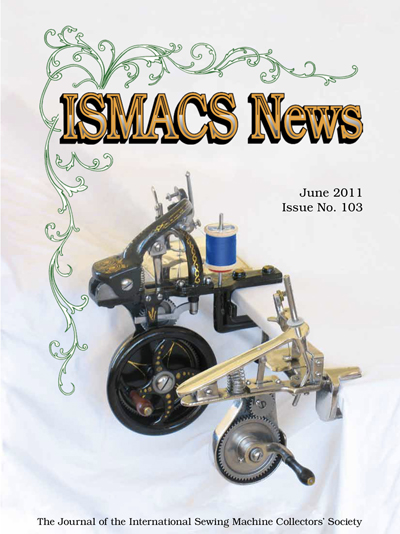The Beckwith Sewing Machine
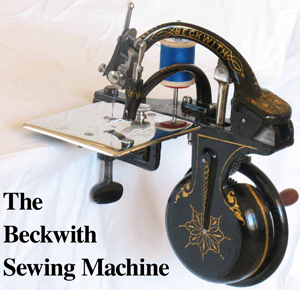
The Beckwith Sewing Machine is often near the top of every sewing machine collector's wish list and, despite being sold as a Family Sewing Machine, because of its small size, it has also become very popular with toy machine collectors.
Due to this popularity, I thought I would offer the following as an initial endeavor to piece together a timeline and brief history of the Beckwith Sewing Machine, from its initial introduction as a small, single-thread, chain stitch machine, to its final production of a larger, yet still portable, machine that was available in either a single- or double-thread configuration.
On April 18, 1871 William Gould Beckwith received a US Patent for an improved sewing machine. Initially weighing less than one pound, it would be sold for just US$10. Beckwith stated in his patent, "My invention consists in certain novel combinations and arrangements of parts, and has for its object to make a cheap and effective single-thread sewing machine".
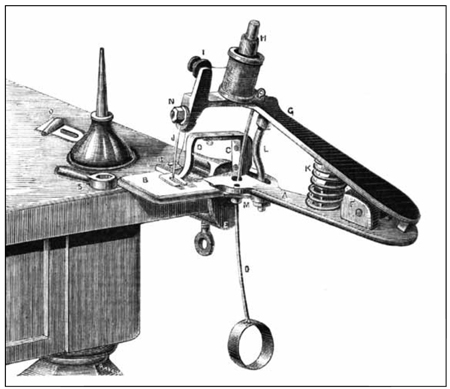
The original Beckwith ringpull machine.
The initial production machine, manufactured by Barlow and Son, New York (Figure 1), closely resembled the machine depicted in his 1871 patent (fig. 2). There was no stand, no treadle and no hand crank. The machine could be fastened to any existing table via the clamp supplied and was operated by a wire and thumb-ring which extended from the bottom of the machine. Beckwith had, indeed, produced a simple, low-cost sewing machine, claiming that it could accomplish all the typical sewing a family household required.
The machine produced a simple, single thread chain stitch, advertised by the company as the "elastic loop-stitch". The cost cutting features are clearly evident in his simple design. Firstly, without a second thread to contend with, there was no manufacturing cost for a shuttle and bobbin, nor any of the related hardware required to drive them. Further savings were achieved by eliminating the need for a cloth feed. The cloth was fed by the needle which, because of the machine's geometry, traveled in a slightly larger arc, causing the cloth to be advanced as the needle pierced and descended into it.
The presser foot was a simple piece of spring steel, bent so as to apply continuous pressure upon the cloth plate. The simple scissor-like design only required a spring to return it to its upward position after a stitch was formed. The looper (hook) was driven by a simple bent rod operating within a slot and the thread tension was achieved by two flat washer, a spring and a nut.

Beckwith's 1871 Patent for the ringpull machine.
So, was it a success? Apparently the machine did sell but it immediately met with criticism that resulted in the company quickly realizing that an improvement was necessary. Though the arrangement of the wire and thumb-ring used to operate the machine served its purpose, it was criticized as having two defects. Firstly, that it required some practice to acquire the motion of the wrist necessary to impel the machine properly and make it do uniform work and, secondly, that the speed was limited to the speed at which it is possible to move the wrist with regularity and without fatigue.
On May 21, 1872, Beckwith received two additional US Patents for improvements to his sewing machine. The wire and thumb-pull had been done away with and had been replaced with a simple gear-driven hand crank (fig. 7). The new gear drive was cleverly supported by its shield which attached to the bottom of the machine. A small pitman connected the upper gear to the same scissor arm to which the wire and ring-pull had once attached. The gear shield, like the rest of the machine, was electro-plated with nickel and then highly polished. The addition of the drive gears and hand crank took the machine from a capacity of approximately 240 stitches per minute to 600 and increased the weight to 1 3/4 pounds.
The available literature suggests that the new machine was being produced and sold several months before the improvements were granted a patent. By March 1872, the American Agriculturist, because of the improvements made to the machine, had reversed its recommendation not to buy this low priced machine and now endorsed it as an option for families who could not afford the more expensive machines. The price for the machined remained at $10 and still included a hemmer, seam guide and four needles.
Having restored and sewn with two of these $10 machines, I can say that it was just adequate to accomplish basic family sewing needs. One of the most saleable points, and one that I think made the machine easy to use, was the cloth feed direction.
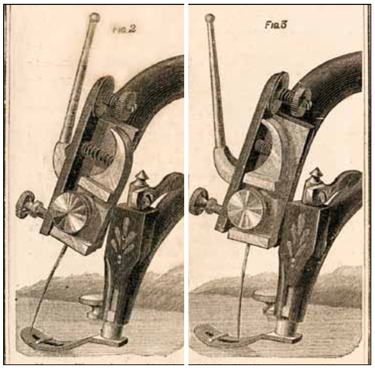
Stitch Length adjustment
For those not familiar with the Beckwith, the cloth is fed towards the operator. Whether this clever part of the design was at first the intention of the inventor or not is unknown. Nonetheless, it became a selling point. It can be seen from the pictures that once clamped to the end of a table, the goods to be sewn could be laid out upon the table. This left the operator free to worry only about guiding the cloth, as it was easily pulled across the table towards them and into their lap.
One side note: due to its design, the hand crank could be operated in either direction and the machine would continue to produce a stitch and feed the cloth toward the operator. There were, though, as a result of its inexpensive design, several areas that warranted improvement. One was the presser foot. In order to begin sewing, one had to lift up the spring steel presser with a finger and then, while holding it up, move the cloth underneath. There is no doubt that the company also realized this and, by the fall of 1872, was offering - on 30 days' trail - an improved $12 dollar machine (figs. 5 & 6).
The $12 machine had an improved, liftable presser foot and the hinge, or pivot joint, was enlarged. This had been necessary to reduce the lateral movement of the needle. The original $10 machine had incorporated a set of lugs, housed within the return spring, which also served this purpose but never completely eliminated the lateral movement. With the larger hinge, these original lugs were removed and the return spring was moved forward and now housed the pitman. With the purchase of the $12 machine, a braider foot was also now included. It appears that, for a short time, both the $10 and $12 machines were offered but, by December 1872, the company made the following statement regarding the $12 machine: "This (referring to the new braider foot), with the other improvements, is considered so important, that the Beckwith Sewing Machine Company will make no more of the $10 style".
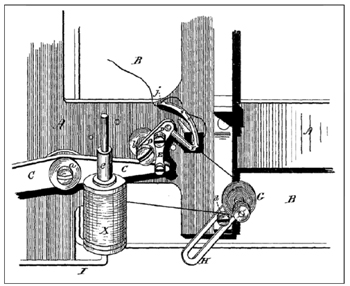
The Beckwith double-thread
By May 1873, approximately one year after adding the gear drive, the company reported "nearly ten thousand of these machines have been sold the past season". If the sales figures are correct, it would help explain the company's endeavor to include the improvements incorporated into the $12 machine and also to introduce an all-new, larger machine just a couple months later (fig. 10).
If you look at the sales ads. in the available literature, both the improved $12 machine and the all-new, larger machine must have been on nearly-parallel design and production paths. There does not appear to be any patent granted for the improved $12 machine and this makes sense, since the improvements - specifically the liftable presser foot - was already in use on other machines. The patent for this larger machine was granted on November 26, 1872.
The company wrote the following about the new machine: "We have, step by step, advanced in our line of progress, securing several patents, manufacturing and selling many thousands of machines, without infringing upon any patent, aiming to produce the best possible machine for the money. Yet many have suggested that if the machine was increased in size and power, it would very much add to its value and popularity, and make it all that heart or hand could desire. We have, therefore, increased the weight from 1 3/4 lbs. to 7 lbs. (4 times), which enlarges its capacity to that of the most expensive first-class family Sewing Machines without impairing its portability."
Advertising for the new machine appears as early as January 1873, when it was being offered on 30 days' trial for a price of $20, with a similar money-back offer as made for the $12 machine.

A side view of Beckwith's $12 machine.
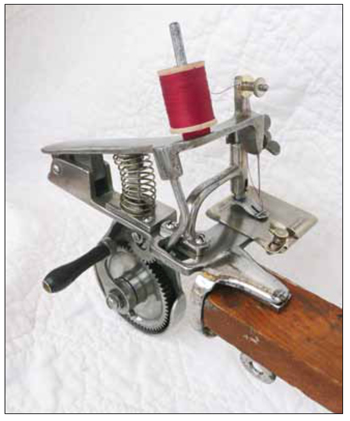
A front view of Beckwith's $12 machine.
The new machine was a vast improvement on its smaller predecessor. The 'bent rod', used to operate the looper, was replaced with a cam and eccentric movement. A balance wheel was added - incorporated as part of the hand crank - and the stitch plate was enlarged.
The needle clamp underwent a complete overhaul to a much improved design, no longer requiring adjustment of the needle within the clamp to vary the stitch length. The machine retained its quick, clamp-on feature and operated, in the author's opinion, very smoothly and easily. The company notes in a September 1873 ad. that "when both are seen and examined in our store on Broadway - the thoroughfare of the world - we never have been able to sell a single $12 Machine, while hundreds of anxious purchasers who could not at once be supplied, have not only left their orders, but also their $20, to secure one at the earliest possible day".
It is interesting to note that the new needle clamp design (figs. 3a/b) was improved from the November 26, 1872 patent. Although it is clearly depicted in the earliest 1873 ads for the new machine, the final production design was not patented until January 20, 1874. The patent for the new needle clamp was not filed until December 31, 1873. Apparently, Beckwith had the idea for the further improvement to his new needle clamp design after filing his initial patent for the new machine but early enough to include it in the first production machines. If there was anything in the new design that would be of key importance to its success, again in the author's opinion, this was it.
With the Beckwith machine, it is the needle clamp - or orientation of the needle within the clamp - that determines the stitch length. The original machine's needle clamp design was as simplistic as it could be. It consisted of a stud, mounted to the upper arm through which a hole was drilled - not unlike most machines of the day. The needle was inserted through the hole and held in place by a washer and wing nut. Peculiar to the design, though, was that the hole in the stud for the needle was larger than necessary for the diameter of the needle used. This larger hole was for stitch length adjustment! By kicking the tip of the needle out, further away from the original machine's needle clamp design was as simplistic as it could be. It consisted of a stud, mounted to the upper arm through which a hole was drilled - not unlike most machines of the day. The needle was inserted through the hole and held in place by a washer and wing nut. Peculiar to the design, though, was that the hole in the stud for the needle was larger than necessary for the diameter of the needle used. This larger hole was for stitch length adjustment! By kicking the tip of the needle out, further away from the operator, a larger stitch length was achieved. Moving it in, towards the operator, reduced the stitch length. I think it could best be described as a successfully cheap but cumbersome way to adjust your stitch length. With some practice, you can learn to loosen the clamp just enough to kick the tip of the needle in or out, without disturbing the setting of the needle height - but, if loosened too much, you could also be changing the needle height.
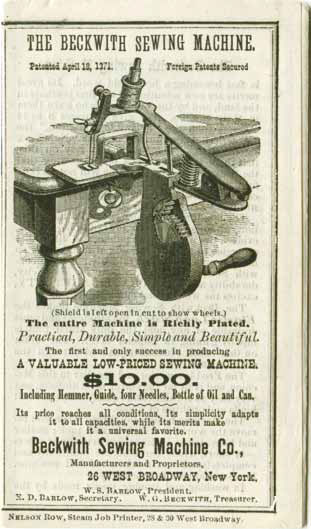
An advertisement for Beckwith's $10 machine.
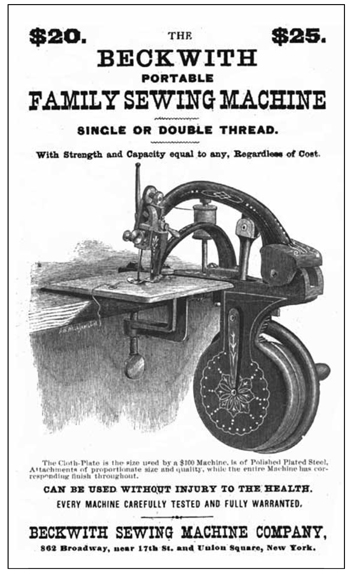
Advertisement for the Single or Double thread Beckwith machine at $20 or $25 dollars.
The new needle clamp design eliminated the earlier cumbersome design and replaced it with a fully adjustable one. The stitch length was still governed by how far the tip of the needle was kicked out but its adjustment was made by the tall lever and thumb screw depicted in figures 3a/b. With this new design the stitch length could be quickly and easily adjusted to a fine degree without disturbing the needle height. There is yet a further point to the new needle clamp design that must be mentioned and understood because it is of key importance to the stitch quality of the new machine. Firstly, as mentioned above, the advancement of the cloth is made by the needle as it descends and passes into the cloth. The distance it moves the cloth (the stitch length) is the difference between the radius of the point of the needle and the place on the needle which travels in the same arc as the needle arm.
The problem with this design is that the same movement that caused the cloth to advance on the descent of the needle also tended to do just the opposite when the needle ascended, resulting in the cloth being pushed back. The design of the original $10 and $12 machines solved this by adding serrations to the bottom of the presser foot so that the cloth would be kept from moving back upon the needle's ascent from the cloth. This design, though, tended to pucker the cloth slightly and provided a less than uniform stitch length. The new needle clamp design solved this problem by allowing the needle to pivot with respect to the arm.
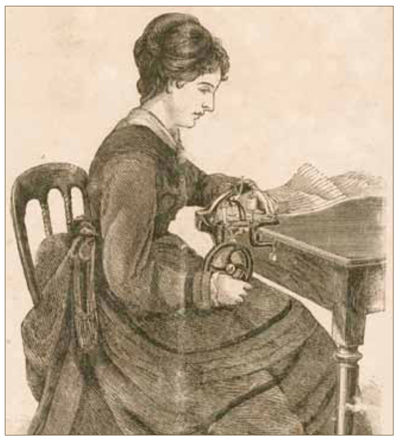
A Beckwith advertisement touting the machine's natural and easy position.
As the needle ascended from the cloth, the tension of the thread caused the tip of the needle to be pulled into a tighter radius (zero stitch length) and thus it no longer pushed the cloth back as it ascended. After the ascent, the thread tension would cease and the needle was returned to its previous setting by the small spring located upon the needle clamp assembly, just below the tension discs, as depicted in figs. 3a/b. The result was a much improved stitch quality that was uniform and even.
Though the price of the new machine had doubled from $10 to $20, it is the opinion of the author that the new machine was a vast improvement upon the original. The increase in size, combined with the mechanical improvements, actually made it the equal of the more costly machines designed for family use. Portability (it weighed just 7lbs) still remained a selling point and, since the unique cloth feed direction of the new machine remained unaltered, it continued to be a selling point (fig. 9).
Although initial sales of the new machine appeared to be good, Beckwith continued to make further modifications. I cannot say whether these changes were better, or if they were invented to satisfy a particular need, for I have never seen either but, because they were advertised for sale, I thought it was necessary to include them in the information.
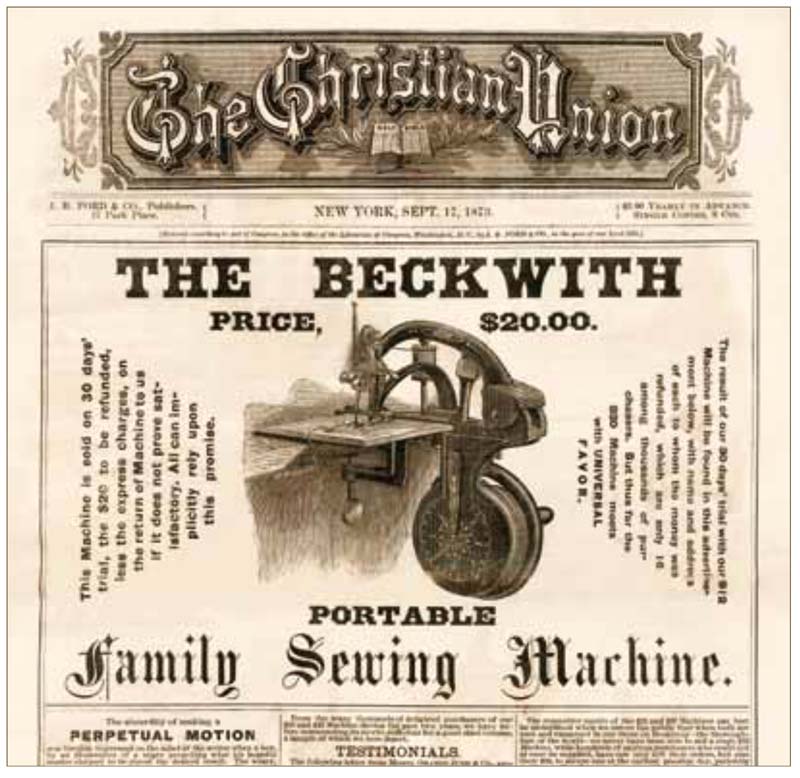
An advertisement in The Christian Union for Beckwith's $10 Family Sewing Machine.
The first change is quite interesting. On January 30, 1875, Beckwith filed a patent application for a two-thread chain stitch version of his new machine. Initially I thought that possibly nothing had ever come of the invention but, after finding an advertisement for the two thread machine, I realized that it was likely produced. Figure 8 depicts the familiar new machine but with the title "Single or Double Thread". It appears that the double-thread machine sold for $25, or $5 more than the single-thread version. Review of the patent reveals that Beckwith figured out how to make his machine produce the well-known Grover & Baker chain stitch.
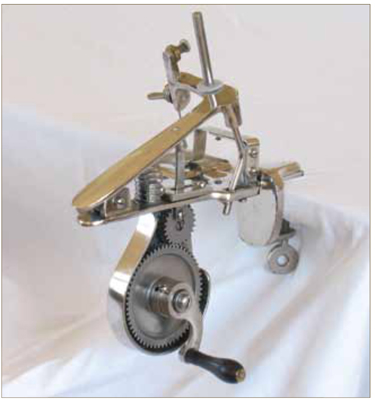
The Beckwith $10 machine.
Figure 4 depicts the underside of the machine's cloth plate with the original looper, or hook, having been replaced with a reciprocating needle assembly. Additionally, a set of tension discs was added, along with a spool pin for the second thread. Like a Grover & Baker, the second thread is taken from the spool, carried between the tension discs, then through the eye at the bend of the reciprocating needle, under the bridge, then finally through the eye at the point as illustrated.
The second modification, and the last in this bit of history, was the introduction of a treadle attachment. After reading through many Beckwith advertisements, which often touted "No Toilsome Tread of the Treadle", it was somewhat surprising to see one being offered. The drawing showed an arrangement similar to that offered by the Grover & Baker hand crank machine: a pedal assembly and what appears to be an adjustable length pitman attached to the hand wheel. The accompanying text suggested that the treadle sold for an additional $5. One can only assume that this attachment completed the Beckwith Family Sewing Machine line, making it usable by all in whatever manner suited them best.
In conclusion, I would prefer to leave this topic open in the hope that it would inspire its readers to dig back through their old paper for additional information, dates and time-lines that could be used to piece together further the Beckwith Sewing Machine history. (DG)
Photos: Lloyd Askew and the author
